Brand Management Report: Strategies and Analysis of M&S Brands
VerifiedAdded on 2021/02/20
|14
|3905
|30
Report
AI Summary
This report provides a comprehensive analysis of brand management, focusing on Marks & Spencer (M&S). It begins with an introduction to brand management, emphasizing its importance in building customer relationships and driving revenue. The report then delves into the components of brand equity, including communication, awareness, legal and ethical decision-making, collaboration, and value. It explores various brand portfolio strategies and brand hierarchy management. The report also examines how brands are managed collaboratively and in partnership, both domestically and globally, with a focus on brand leveraging. Furthermore, it analyzes M&S's strengths and weaknesses, including consumer understanding, innovation, brand-building, and marketing. Finally, the report discusses different techniques for measuring and managing brand value, such as brand awareness, market share, consumer attitudes, and purchasing intent, concluding with a summary of the findings and recommendations.

BRAND MANAGEMENT
Paraphrase This Document
Need a fresh take? Get an instant paraphrase of this document with our AI Paraphraser
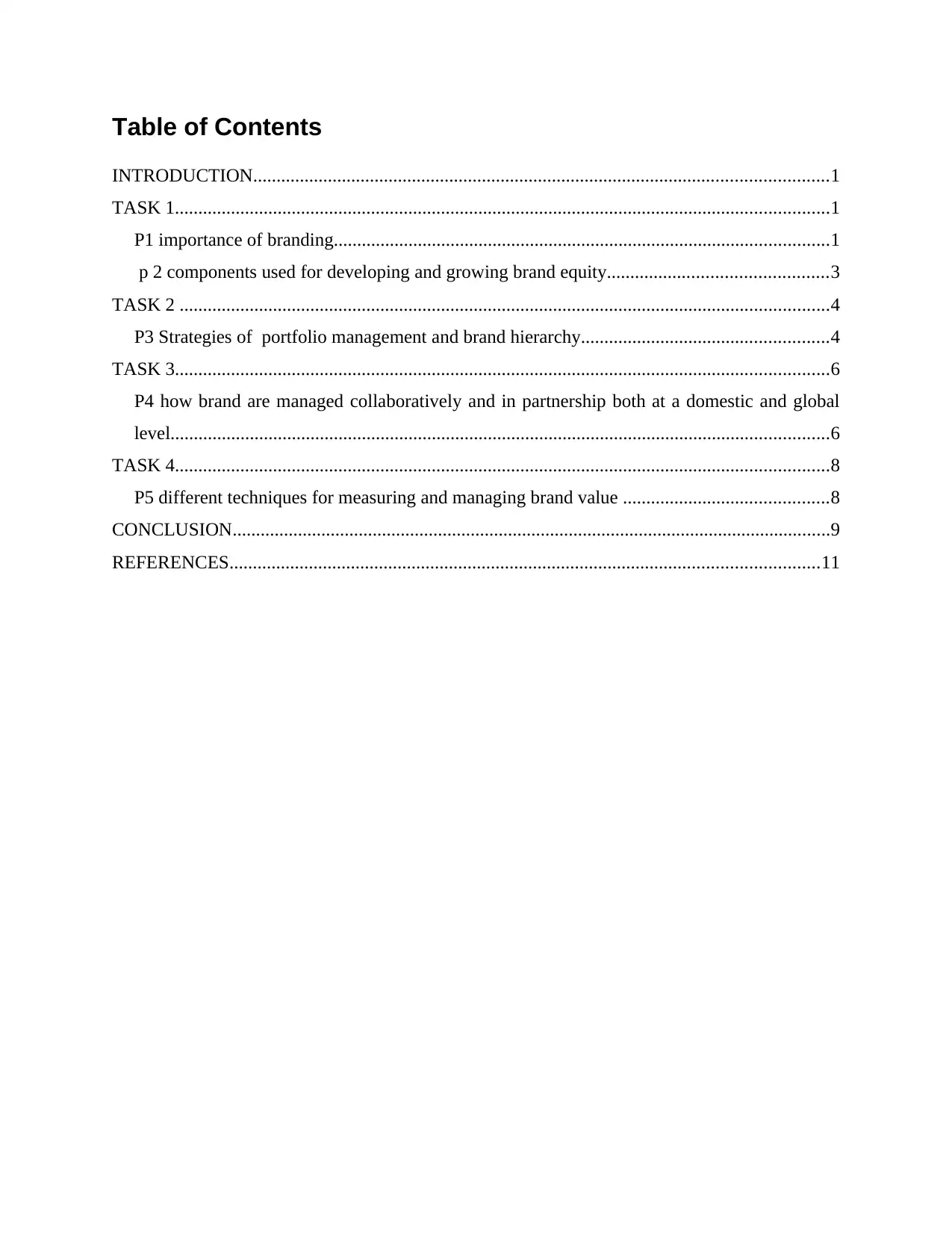
Table of Contents
INTRODUCTION...........................................................................................................................1
TASK 1............................................................................................................................................1
P1 importance of branding..........................................................................................................1
p 2 components used for developing and growing brand equity...............................................3
TASK 2 ...........................................................................................................................................4
P3 Strategies of portfolio management and brand hierarchy.....................................................4
TASK 3............................................................................................................................................6
P4 how brand are managed collaboratively and in partnership both at a domestic and global
level.............................................................................................................................................6
TASK 4............................................................................................................................................8
P5 different techniques for measuring and managing brand value ............................................8
CONCLUSION................................................................................................................................9
REFERENCES..............................................................................................................................11
INTRODUCTION...........................................................................................................................1
TASK 1............................................................................................................................................1
P1 importance of branding..........................................................................................................1
p 2 components used for developing and growing brand equity...............................................3
TASK 2 ...........................................................................................................................................4
P3 Strategies of portfolio management and brand hierarchy.....................................................4
TASK 3............................................................................................................................................6
P4 how brand are managed collaboratively and in partnership both at a domestic and global
level.............................................................................................................................................6
TASK 4............................................................................................................................................8
P5 different techniques for measuring and managing brand value ............................................8
CONCLUSION................................................................................................................................9
REFERENCES..............................................................................................................................11
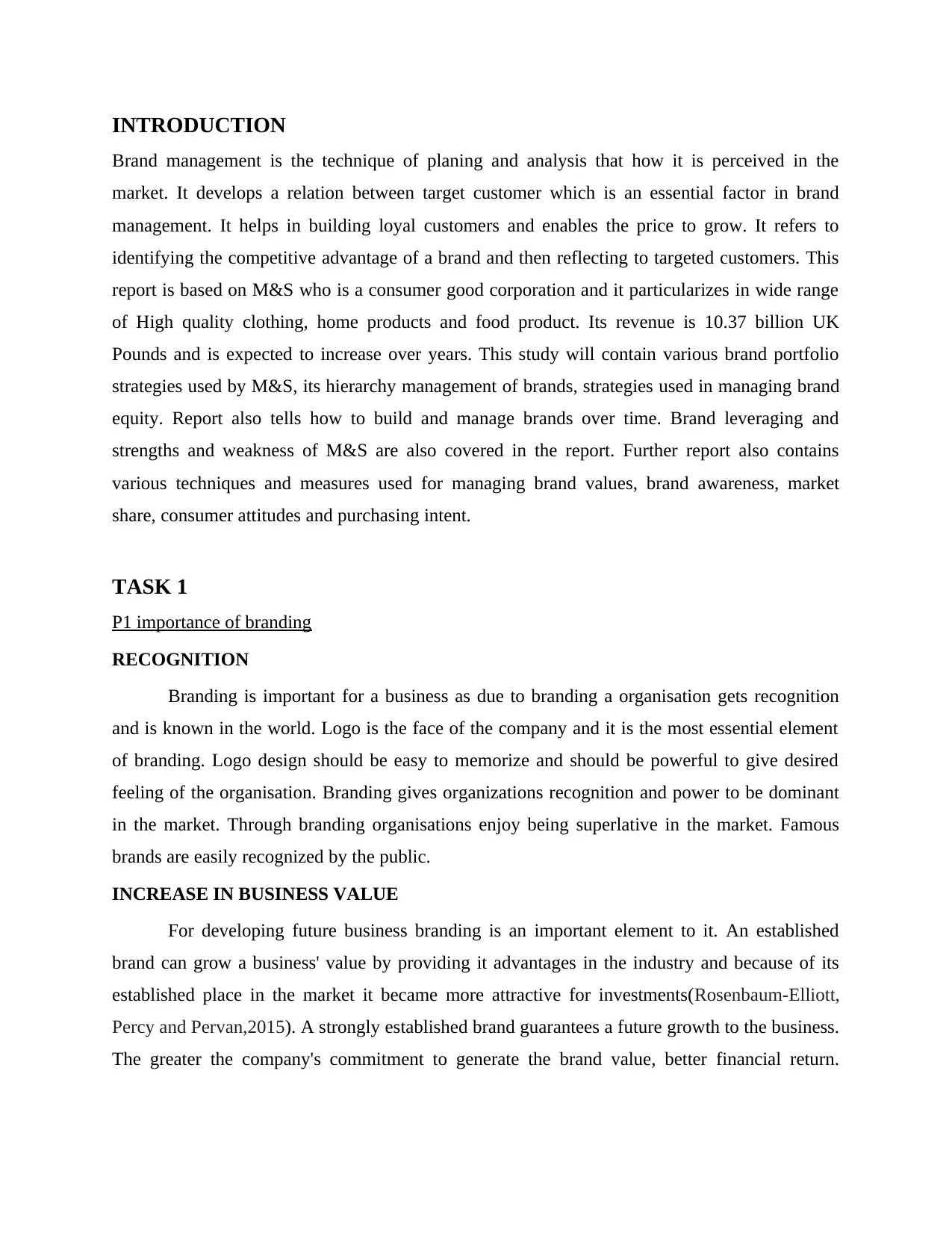
INTRODUCTION
Brand management is the technique of planing and analysis that how it is perceived in the
market. It develops a relation between target customer which is an essential factor in brand
management. It helps in building loyal customers and enables the price to grow. It refers to
identifying the competitive advantage of a brand and then reflecting to targeted customers. This
report is based on M&S who is a consumer good corporation and it particularizes in wide range
of High quality clothing, home products and food product. Its revenue is 10.37 billion UK
Pounds and is expected to increase over years. This study will contain various brand portfolio
strategies used by M&S, its hierarchy management of brands, strategies used in managing brand
equity. Report also tells how to build and manage brands over time. Brand leveraging and
strengths and weakness of M&S are also covered in the report. Further report also contains
various techniques and measures used for managing brand values, brand awareness, market
share, consumer attitudes and purchasing intent.
TASK 1
P1 importance of branding
RECOGNITION
Branding is important for a business as due to branding a organisation gets recognition
and is known in the world. Logo is the face of the company and it is the most essential element
of branding. Logo design should be easy to memorize and should be powerful to give desired
feeling of the organisation. Branding gives organizations recognition and power to be dominant
in the market. Through branding organisations enjoy being superlative in the market. Famous
brands are easily recognized by the public.
INCREASE IN BUSINESS VALUE
For developing future business branding is an important element to it. An established
brand can grow a business' value by providing it advantages in the industry and because of its
established place in the market it became more attractive for investments(Rosenbaum-Elliott,
Percy and Pervan,2015). A strongly established brand guarantees a future growth to the business.
The greater the company's commitment to generate the brand value, better financial return.
Brand management is the technique of planing and analysis that how it is perceived in the
market. It develops a relation between target customer which is an essential factor in brand
management. It helps in building loyal customers and enables the price to grow. It refers to
identifying the competitive advantage of a brand and then reflecting to targeted customers. This
report is based on M&S who is a consumer good corporation and it particularizes in wide range
of High quality clothing, home products and food product. Its revenue is 10.37 billion UK
Pounds and is expected to increase over years. This study will contain various brand portfolio
strategies used by M&S, its hierarchy management of brands, strategies used in managing brand
equity. Report also tells how to build and manage brands over time. Brand leveraging and
strengths and weakness of M&S are also covered in the report. Further report also contains
various techniques and measures used for managing brand values, brand awareness, market
share, consumer attitudes and purchasing intent.
TASK 1
P1 importance of branding
RECOGNITION
Branding is important for a business as due to branding a organisation gets recognition
and is known in the world. Logo is the face of the company and it is the most essential element
of branding. Logo design should be easy to memorize and should be powerful to give desired
feeling of the organisation. Branding gives organizations recognition and power to be dominant
in the market. Through branding organisations enjoy being superlative in the market. Famous
brands are easily recognized by the public.
INCREASE IN BUSINESS VALUE
For developing future business branding is an important element to it. An established
brand can grow a business' value by providing it advantages in the industry and because of its
established place in the market it became more attractive for investments(Rosenbaum-Elliott,
Percy and Pervan,2015). A strongly established brand guarantees a future growth to the business.
The greater the company's commitment to generate the brand value, better financial return.
⊘ This is a preview!⊘
Do you want full access?
Subscribe today to unlock all pages.

Trusted by 1+ million students worldwide
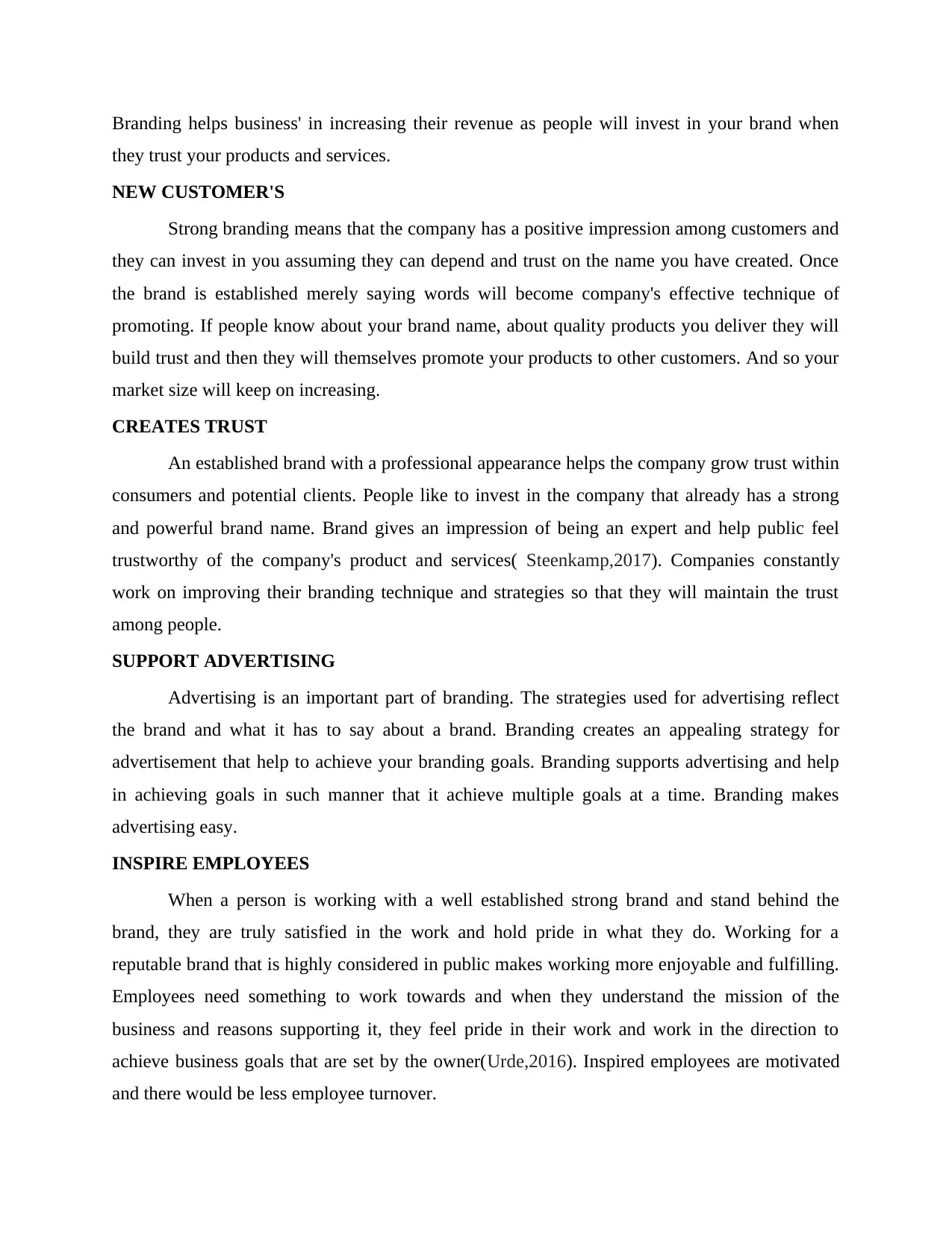
Branding helps business' in increasing their revenue as people will invest in your brand when
they trust your products and services.
NEW CUSTOMER'S
Strong branding means that the company has a positive impression among customers and
they can invest in you assuming they can depend and trust on the name you have created. Once
the brand is established merely saying words will become company's effective technique of
promoting. If people know about your brand name, about quality products you deliver they will
build trust and then they will themselves promote your products to other customers. And so your
market size will keep on increasing.
CREATES TRUST
An established brand with a professional appearance helps the company grow trust within
consumers and potential clients. People like to invest in the company that already has a strong
and powerful brand name. Brand gives an impression of being an expert and help public feel
trustworthy of the company's product and services( Steenkamp,2017). Companies constantly
work on improving their branding technique and strategies so that they will maintain the trust
among people.
SUPPORT ADVERTISING
Advertising is an important part of branding. The strategies used for advertising reflect
the brand and what it has to say about a brand. Branding creates an appealing strategy for
advertisement that help to achieve your branding goals. Branding supports advertising and help
in achieving goals in such manner that it achieve multiple goals at a time. Branding makes
advertising easy.
INSPIRE EMPLOYEES
When a person is working with a well established strong brand and stand behind the
brand, they are truly satisfied in the work and hold pride in what they do. Working for a
reputable brand that is highly considered in public makes working more enjoyable and fulfilling.
Employees need something to work towards and when they understand the mission of the
business and reasons supporting it, they feel pride in their work and work in the direction to
achieve business goals that are set by the owner(Urde,2016). Inspired employees are motivated
and there would be less employee turnover.
they trust your products and services.
NEW CUSTOMER'S
Strong branding means that the company has a positive impression among customers and
they can invest in you assuming they can depend and trust on the name you have created. Once
the brand is established merely saying words will become company's effective technique of
promoting. If people know about your brand name, about quality products you deliver they will
build trust and then they will themselves promote your products to other customers. And so your
market size will keep on increasing.
CREATES TRUST
An established brand with a professional appearance helps the company grow trust within
consumers and potential clients. People like to invest in the company that already has a strong
and powerful brand name. Brand gives an impression of being an expert and help public feel
trustworthy of the company's product and services( Steenkamp,2017). Companies constantly
work on improving their branding technique and strategies so that they will maintain the trust
among people.
SUPPORT ADVERTISING
Advertising is an important part of branding. The strategies used for advertising reflect
the brand and what it has to say about a brand. Branding creates an appealing strategy for
advertisement that help to achieve your branding goals. Branding supports advertising and help
in achieving goals in such manner that it achieve multiple goals at a time. Branding makes
advertising easy.
INSPIRE EMPLOYEES
When a person is working with a well established strong brand and stand behind the
brand, they are truly satisfied in the work and hold pride in what they do. Working for a
reputable brand that is highly considered in public makes working more enjoyable and fulfilling.
Employees need something to work towards and when they understand the mission of the
business and reasons supporting it, they feel pride in their work and work in the direction to
achieve business goals that are set by the owner(Urde,2016). Inspired employees are motivated
and there would be less employee turnover.
Paraphrase This Document
Need a fresh take? Get an instant paraphrase of this document with our AI Paraphraser
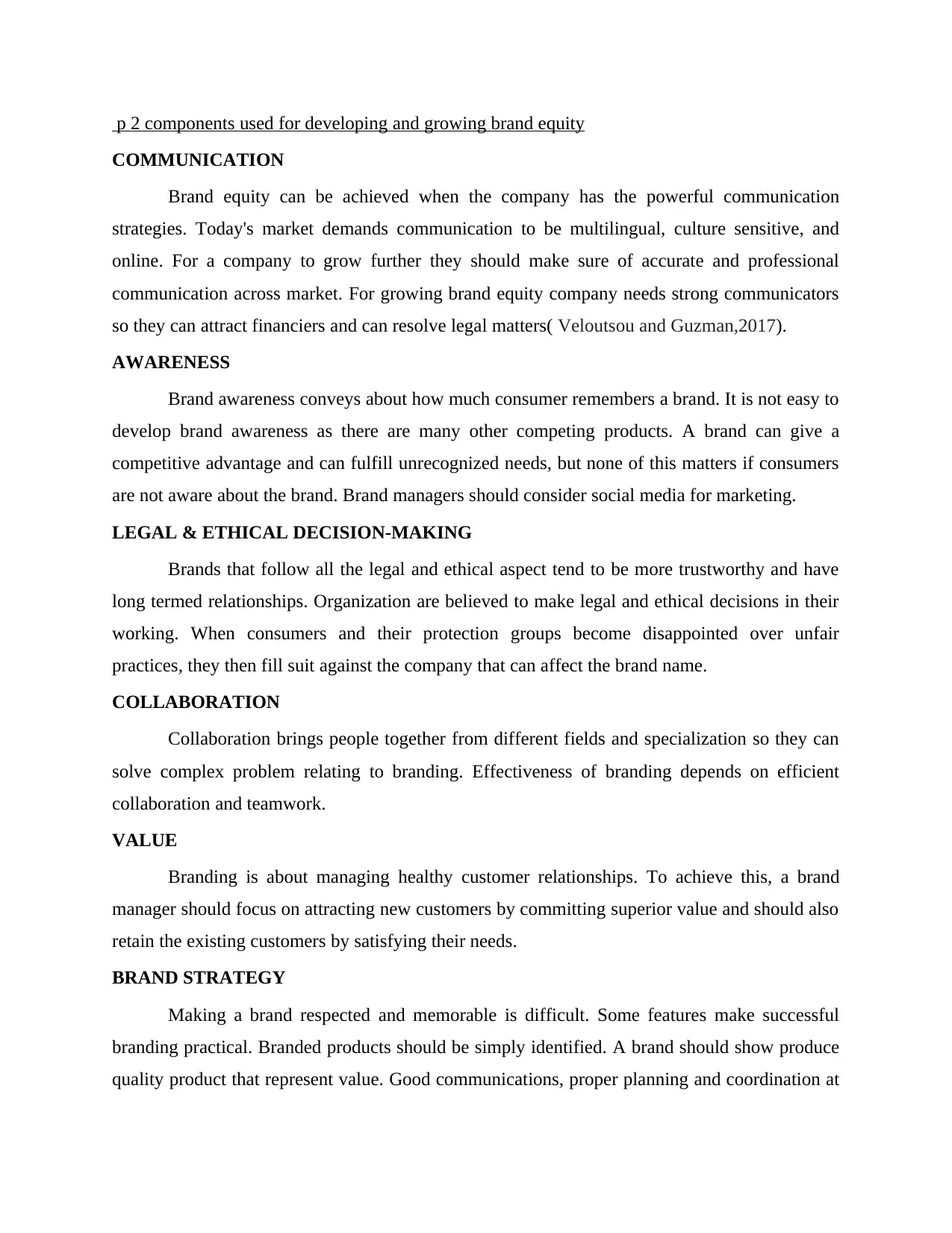
p 2 components used for developing and growing brand equity
COMMUNICATION
Brand equity can be achieved when the company has the powerful communication
strategies. Today's market demands communication to be multilingual, culture sensitive, and
online. For a company to grow further they should make sure of accurate and professional
communication across market. For growing brand equity company needs strong communicators
so they can attract financiers and can resolve legal matters( Veloutsou and Guzman,2017).
AWARENESS
Brand awareness conveys about how much consumer remembers a brand. It is not easy to
develop brand awareness as there are many other competing products. A brand can give a
competitive advantage and can fulfill unrecognized needs, but none of this matters if consumers
are not aware about the brand. Brand managers should consider social media for marketing.
LEGAL & ETHICAL DECISION-MAKING
Brands that follow all the legal and ethical aspect tend to be more trustworthy and have
long termed relationships. Organization are believed to make legal and ethical decisions in their
working. When consumers and their protection groups become disappointed over unfair
practices, they then fill suit against the company that can affect the brand name.
COLLABORATION
Collaboration brings people together from different fields and specialization so they can
solve complex problem relating to branding. Effectiveness of branding depends on efficient
collaboration and teamwork.
VALUE
Branding is about managing healthy customer relationships. To achieve this, a brand
manager should focus on attracting new customers by committing superior value and should also
retain the existing customers by satisfying their needs.
BRAND STRATEGY
Making a brand respected and memorable is difficult. Some features make successful
branding practical. Branded products should be simply identified. A brand should show produce
quality product that represent value. Good communications, proper planning and coordination at
COMMUNICATION
Brand equity can be achieved when the company has the powerful communication
strategies. Today's market demands communication to be multilingual, culture sensitive, and
online. For a company to grow further they should make sure of accurate and professional
communication across market. For growing brand equity company needs strong communicators
so they can attract financiers and can resolve legal matters( Veloutsou and Guzman,2017).
AWARENESS
Brand awareness conveys about how much consumer remembers a brand. It is not easy to
develop brand awareness as there are many other competing products. A brand can give a
competitive advantage and can fulfill unrecognized needs, but none of this matters if consumers
are not aware about the brand. Brand managers should consider social media for marketing.
LEGAL & ETHICAL DECISION-MAKING
Brands that follow all the legal and ethical aspect tend to be more trustworthy and have
long termed relationships. Organization are believed to make legal and ethical decisions in their
working. When consumers and their protection groups become disappointed over unfair
practices, they then fill suit against the company that can affect the brand name.
COLLABORATION
Collaboration brings people together from different fields and specialization so they can
solve complex problem relating to branding. Effectiveness of branding depends on efficient
collaboration and teamwork.
VALUE
Branding is about managing healthy customer relationships. To achieve this, a brand
manager should focus on attracting new customers by committing superior value and should also
retain the existing customers by satisfying their needs.
BRAND STRATEGY
Making a brand respected and memorable is difficult. Some features make successful
branding practical. Branded products should be simply identified. A brand should show produce
quality product that represent value. Good communications, proper planning and coordination at
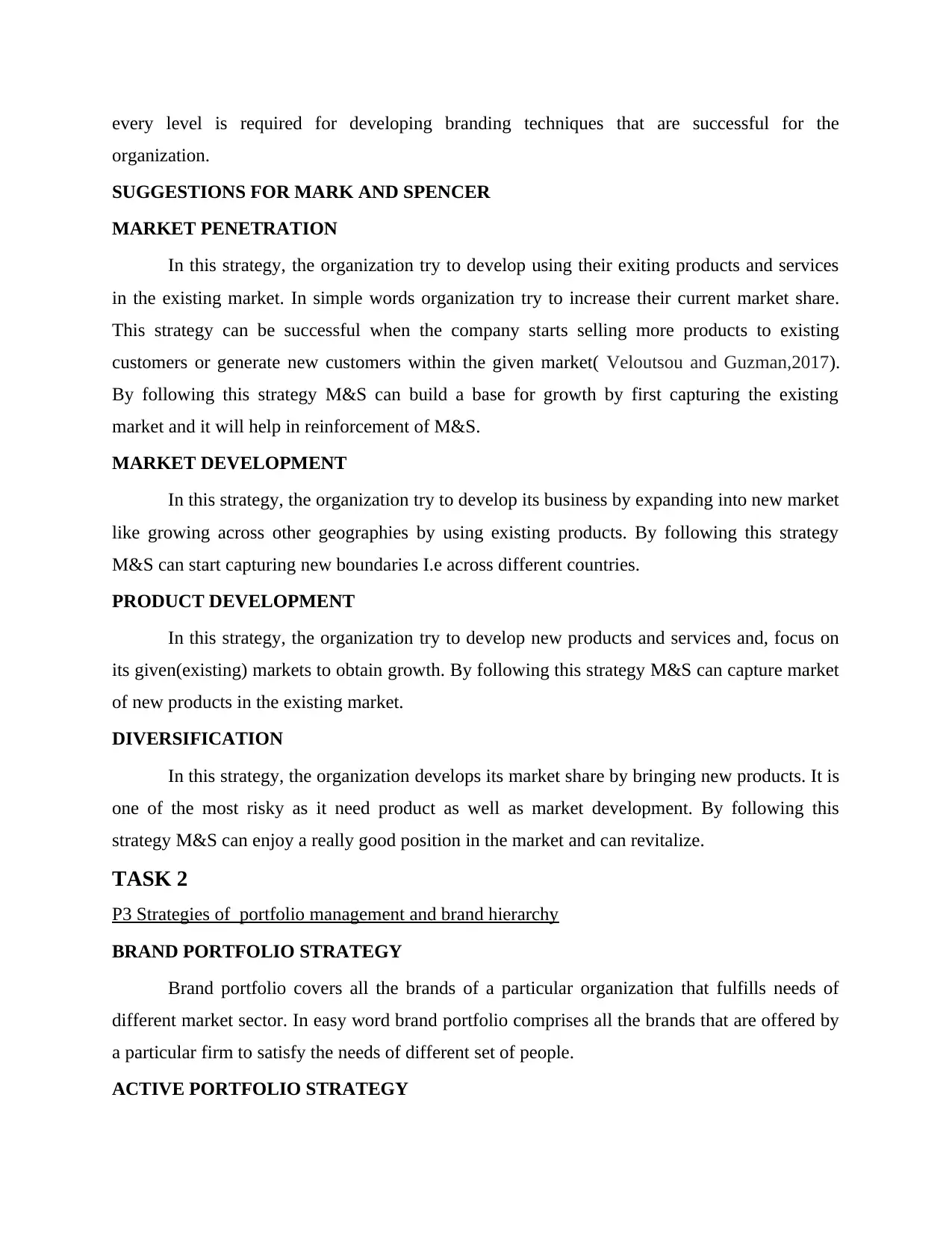
every level is required for developing branding techniques that are successful for the
organization.
SUGGESTIONS FOR MARK AND SPENCER
MARKET PENETRATION
In this strategy, the organization try to develop using their exiting products and services
in the existing market. In simple words organization try to increase their current market share.
This strategy can be successful when the company starts selling more products to existing
customers or generate new customers within the given market( Veloutsou and Guzman,2017).
By following this strategy M&S can build a base for growth by first capturing the existing
market and it will help in reinforcement of M&S.
MARKET DEVELOPMENT
In this strategy, the organization try to develop its business by expanding into new market
like growing across other geographies by using existing products. By following this strategy
M&S can start capturing new boundaries I.e across different countries.
PRODUCT DEVELOPMENT
In this strategy, the organization try to develop new products and services and, focus on
its given(existing) markets to obtain growth. By following this strategy M&S can capture market
of new products in the existing market.
DIVERSIFICATION
In this strategy, the organization develops its market share by bringing new products. It is
one of the most risky as it need product as well as market development. By following this
strategy M&S can enjoy a really good position in the market and can revitalize.
TASK 2
P3 Strategies of portfolio management and brand hierarchy
BRAND PORTFOLIO STRATEGY
Brand portfolio covers all the brands of a particular organization that fulfills needs of
different market sector. In easy word brand portfolio comprises all the brands that are offered by
a particular firm to satisfy the needs of different set of people.
ACTIVE PORTFOLIO STRATEGY
organization.
SUGGESTIONS FOR MARK AND SPENCER
MARKET PENETRATION
In this strategy, the organization try to develop using their exiting products and services
in the existing market. In simple words organization try to increase their current market share.
This strategy can be successful when the company starts selling more products to existing
customers or generate new customers within the given market( Veloutsou and Guzman,2017).
By following this strategy M&S can build a base for growth by first capturing the existing
market and it will help in reinforcement of M&S.
MARKET DEVELOPMENT
In this strategy, the organization try to develop its business by expanding into new market
like growing across other geographies by using existing products. By following this strategy
M&S can start capturing new boundaries I.e across different countries.
PRODUCT DEVELOPMENT
In this strategy, the organization try to develop new products and services and, focus on
its given(existing) markets to obtain growth. By following this strategy M&S can capture market
of new products in the existing market.
DIVERSIFICATION
In this strategy, the organization develops its market share by bringing new products. It is
one of the most risky as it need product as well as market development. By following this
strategy M&S can enjoy a really good position in the market and can revitalize.
TASK 2
P3 Strategies of portfolio management and brand hierarchy
BRAND PORTFOLIO STRATEGY
Brand portfolio covers all the brands of a particular organization that fulfills needs of
different market sector. In easy word brand portfolio comprises all the brands that are offered by
a particular firm to satisfy the needs of different set of people.
ACTIVE PORTFOLIO STRATEGY
⊘ This is a preview!⊘
Do you want full access?
Subscribe today to unlock all pages.

Trusted by 1+ million students worldwide
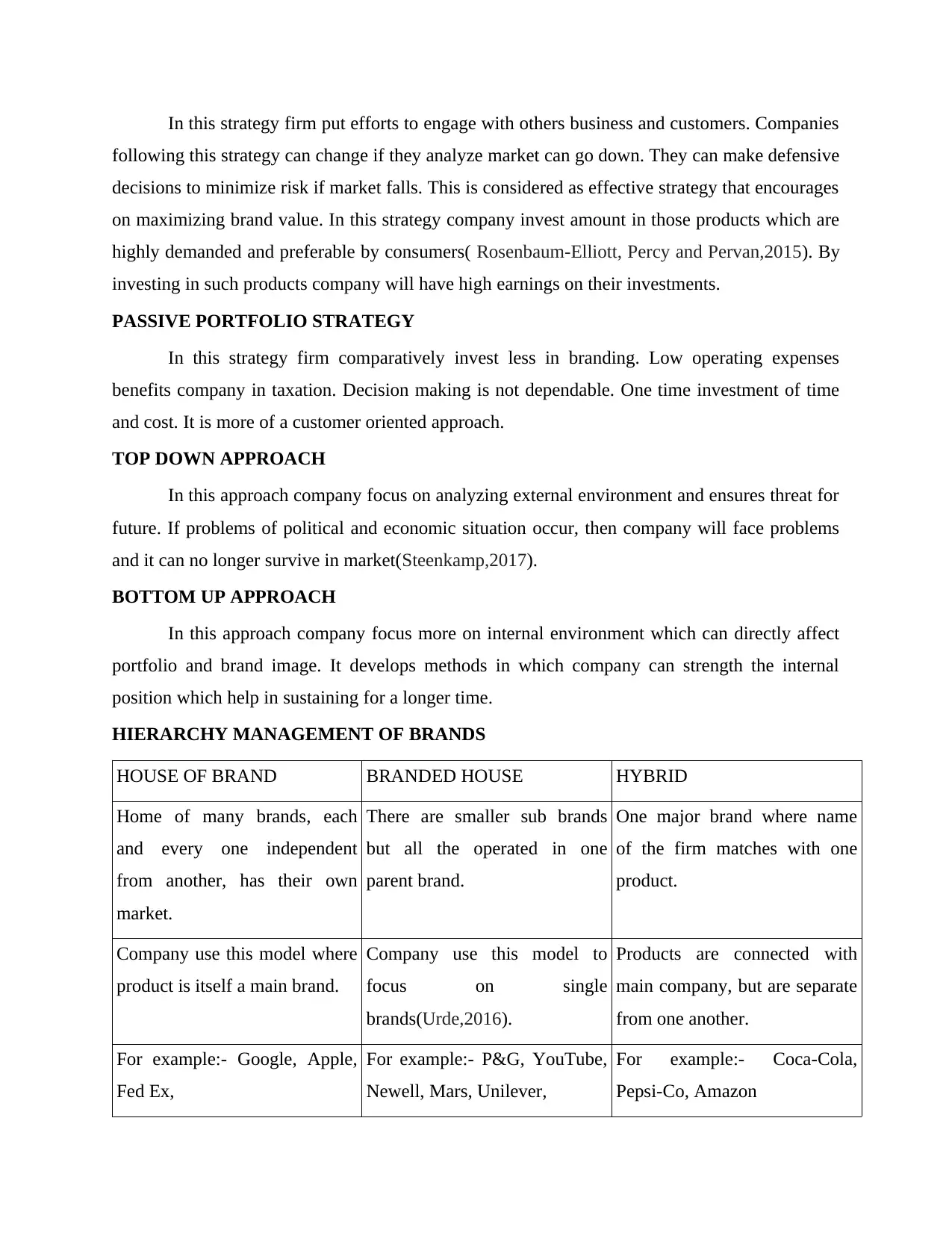
In this strategy firm put efforts to engage with others business and customers. Companies
following this strategy can change if they analyze market can go down. They can make defensive
decisions to minimize risk if market falls. This is considered as effective strategy that encourages
on maximizing brand value. In this strategy company invest amount in those products which are
highly demanded and preferable by consumers( Rosenbaum-Elliott, Percy and Pervan,2015). By
investing in such products company will have high earnings on their investments.
PASSIVE PORTFOLIO STRATEGY
In this strategy firm comparatively invest less in branding. Low operating expenses
benefits company in taxation. Decision making is not dependable. One time investment of time
and cost. It is more of a customer oriented approach.
TOP DOWN APPROACH
In this approach company focus on analyzing external environment and ensures threat for
future. If problems of political and economic situation occur, then company will face problems
and it can no longer survive in market(Steenkamp,2017).
BOTTOM UP APPROACH
In this approach company focus more on internal environment which can directly affect
portfolio and brand image. It develops methods in which company can strength the internal
position which help in sustaining for a longer time.
HIERARCHY MANAGEMENT OF BRANDS
HOUSE OF BRAND BRANDED HOUSE HYBRID
Home of many brands, each
and every one independent
from another, has their own
market.
There are smaller sub brands
but all the operated in one
parent brand.
One major brand where name
of the firm matches with one
product.
Company use this model where
product is itself a main brand.
Company use this model to
focus on single
brands(Urde,2016).
Products are connected with
main company, but are separate
from one another.
For example:- Google, Apple,
Fed Ex,
For example:- P&G, YouTube,
Newell, Mars, Unilever,
For example:- Coca-Cola,
Pepsi-Co, Amazon
following this strategy can change if they analyze market can go down. They can make defensive
decisions to minimize risk if market falls. This is considered as effective strategy that encourages
on maximizing brand value. In this strategy company invest amount in those products which are
highly demanded and preferable by consumers( Rosenbaum-Elliott, Percy and Pervan,2015). By
investing in such products company will have high earnings on their investments.
PASSIVE PORTFOLIO STRATEGY
In this strategy firm comparatively invest less in branding. Low operating expenses
benefits company in taxation. Decision making is not dependable. One time investment of time
and cost. It is more of a customer oriented approach.
TOP DOWN APPROACH
In this approach company focus on analyzing external environment and ensures threat for
future. If problems of political and economic situation occur, then company will face problems
and it can no longer survive in market(Steenkamp,2017).
BOTTOM UP APPROACH
In this approach company focus more on internal environment which can directly affect
portfolio and brand image. It develops methods in which company can strength the internal
position which help in sustaining for a longer time.
HIERARCHY MANAGEMENT OF BRANDS
HOUSE OF BRAND BRANDED HOUSE HYBRID
Home of many brands, each
and every one independent
from another, has their own
market.
There are smaller sub brands
but all the operated in one
parent brand.
One major brand where name
of the firm matches with one
product.
Company use this model where
product is itself a main brand.
Company use this model to
focus on single
brands(Urde,2016).
Products are connected with
main company, but are separate
from one another.
For example:- Google, Apple,
Fed Ex,
For example:- P&G, YouTube,
Newell, Mars, Unilever,
For example:- Coca-Cola,
Pepsi-Co, Amazon
Paraphrase This Document
Need a fresh take? Get an instant paraphrase of this document with our AI Paraphraser
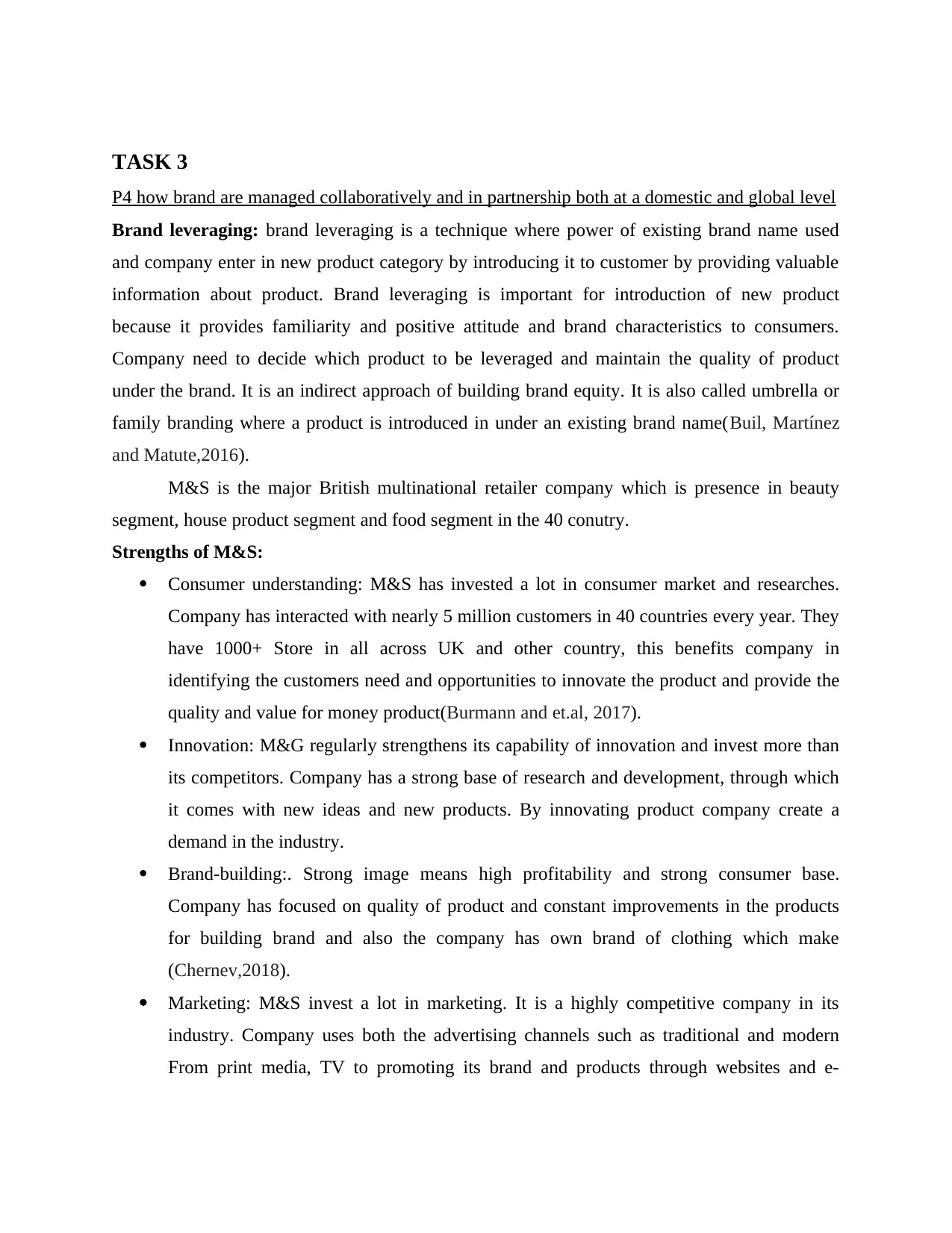
TASK 3
P4 how brand are managed collaboratively and in partnership both at a domestic and global level
Brand leveraging: brand leveraging is a technique where power of existing brand name used
and company enter in new product category by introducing it to customer by providing valuable
information about product. Brand leveraging is important for introduction of new product
because it provides familiarity and positive attitude and brand characteristics to consumers.
Company need to decide which product to be leveraged and maintain the quality of product
under the brand. It is an indirect approach of building brand equity. It is also called umbrella or
family branding where a product is introduced in under an existing brand name(Buil, Martínez
and Matute,2016).
M&S is the major British multinational retailer company which is presence in beauty
segment, house product segment and food segment in the 40 conutry.
Strengths of M&S:
Consumer understanding: M&S has invested a lot in consumer market and researches.
Company has interacted with nearly 5 million customers in 40 countries every year. They
have 1000+ Store in all across UK and other country, this benefits company in
identifying the customers need and opportunities to innovate the product and provide the
quality and value for money product(Burmann and et.al, 2017).
Innovation: M&G regularly strengthens its capability of innovation and invest more than
its competitors. Company has a strong base of research and development, through which
it comes with new ideas and new products. By innovating product company create a
demand in the industry.
Brand-building:. Strong image means high profitability and strong consumer base.
Company has focused on quality of product and constant improvements in the products
for building brand and also the company has own brand of clothing which make
(Chernev,2018).
Marketing: M&S invest a lot in marketing. It is a highly competitive company in its
industry. Company uses both the advertising channels such as traditional and modern
From print media, TV to promoting its brand and products through websites and e-
P4 how brand are managed collaboratively and in partnership both at a domestic and global level
Brand leveraging: brand leveraging is a technique where power of existing brand name used
and company enter in new product category by introducing it to customer by providing valuable
information about product. Brand leveraging is important for introduction of new product
because it provides familiarity and positive attitude and brand characteristics to consumers.
Company need to decide which product to be leveraged and maintain the quality of product
under the brand. It is an indirect approach of building brand equity. It is also called umbrella or
family branding where a product is introduced in under an existing brand name(Buil, Martínez
and Matute,2016).
M&S is the major British multinational retailer company which is presence in beauty
segment, house product segment and food segment in the 40 conutry.
Strengths of M&S:
Consumer understanding: M&S has invested a lot in consumer market and researches.
Company has interacted with nearly 5 million customers in 40 countries every year. They
have 1000+ Store in all across UK and other country, this benefits company in
identifying the customers need and opportunities to innovate the product and provide the
quality and value for money product(Burmann and et.al, 2017).
Innovation: M&G regularly strengthens its capability of innovation and invest more than
its competitors. Company has a strong base of research and development, through which
it comes with new ideas and new products. By innovating product company create a
demand in the industry.
Brand-building:. Strong image means high profitability and strong consumer base.
Company has focused on quality of product and constant improvements in the products
for building brand and also the company has own brand of clothing which make
(Chernev,2018).
Marketing: M&S invest a lot in marketing. It is a highly competitive company in its
industry. Company uses both the advertising channels such as traditional and modern
From print media, TV to promoting its brand and products through websites and e-
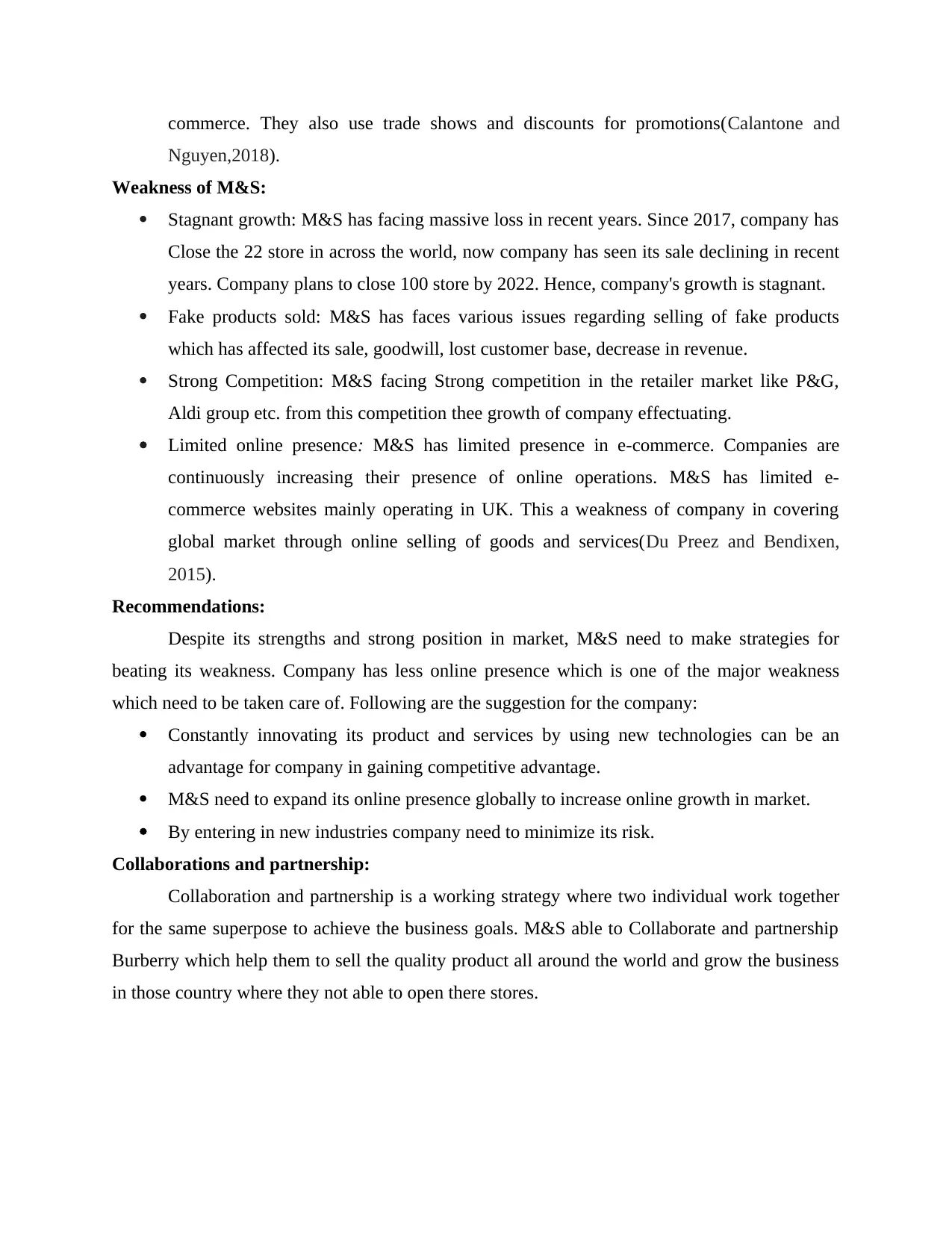
commerce. They also use trade shows and discounts for promotions(Calantone and
Nguyen,2018).
Weakness of M&S:
Stagnant growth: M&S has facing massive loss in recent years. Since 2017, company has
Close the 22 store in across the world, now company has seen its sale declining in recent
years. Company plans to close 100 store by 2022. Hence, company's growth is stagnant.
Fake products sold: M&S has faces various issues regarding selling of fake products
which has affected its sale, goodwill, lost customer base, decrease in revenue.
Strong Competition: M&S facing Strong competition in the retailer market like P&G,
Aldi group etc. from this competition thee growth of company effectuating.
Limited online presence: M&S has limited presence in e-commerce. Companies are
continuously increasing their presence of online operations. M&S has limited e-
commerce websites mainly operating in UK. This a weakness of company in covering
global market through online selling of goods and services(Du Preez and Bendixen,
2015).
Recommendations:
Despite its strengths and strong position in market, M&S need to make strategies for
beating its weakness. Company has less online presence which is one of the major weakness
which need to be taken care of. Following are the suggestion for the company:
Constantly innovating its product and services by using new technologies can be an
advantage for company in gaining competitive advantage.
M&S need to expand its online presence globally to increase online growth in market.
By entering in new industries company need to minimize its risk.
Collaborations and partnership:
Collaboration and partnership is a working strategy where two individual work together
for the same superpose to achieve the business goals. M&S able to Collaborate and partnership
Burberry which help them to sell the quality product all around the world and grow the business
in those country where they not able to open there stores.
Nguyen,2018).
Weakness of M&S:
Stagnant growth: M&S has facing massive loss in recent years. Since 2017, company has
Close the 22 store in across the world, now company has seen its sale declining in recent
years. Company plans to close 100 store by 2022. Hence, company's growth is stagnant.
Fake products sold: M&S has faces various issues regarding selling of fake products
which has affected its sale, goodwill, lost customer base, decrease in revenue.
Strong Competition: M&S facing Strong competition in the retailer market like P&G,
Aldi group etc. from this competition thee growth of company effectuating.
Limited online presence: M&S has limited presence in e-commerce. Companies are
continuously increasing their presence of online operations. M&S has limited e-
commerce websites mainly operating in UK. This a weakness of company in covering
global market through online selling of goods and services(Du Preez and Bendixen,
2015).
Recommendations:
Despite its strengths and strong position in market, M&S need to make strategies for
beating its weakness. Company has less online presence which is one of the major weakness
which need to be taken care of. Following are the suggestion for the company:
Constantly innovating its product and services by using new technologies can be an
advantage for company in gaining competitive advantage.
M&S need to expand its online presence globally to increase online growth in market.
By entering in new industries company need to minimize its risk.
Collaborations and partnership:
Collaboration and partnership is a working strategy where two individual work together
for the same superpose to achieve the business goals. M&S able to Collaborate and partnership
Burberry which help them to sell the quality product all around the world and grow the business
in those country where they not able to open there stores.
⊘ This is a preview!⊘
Do you want full access?
Subscribe today to unlock all pages.

Trusted by 1+ million students worldwide
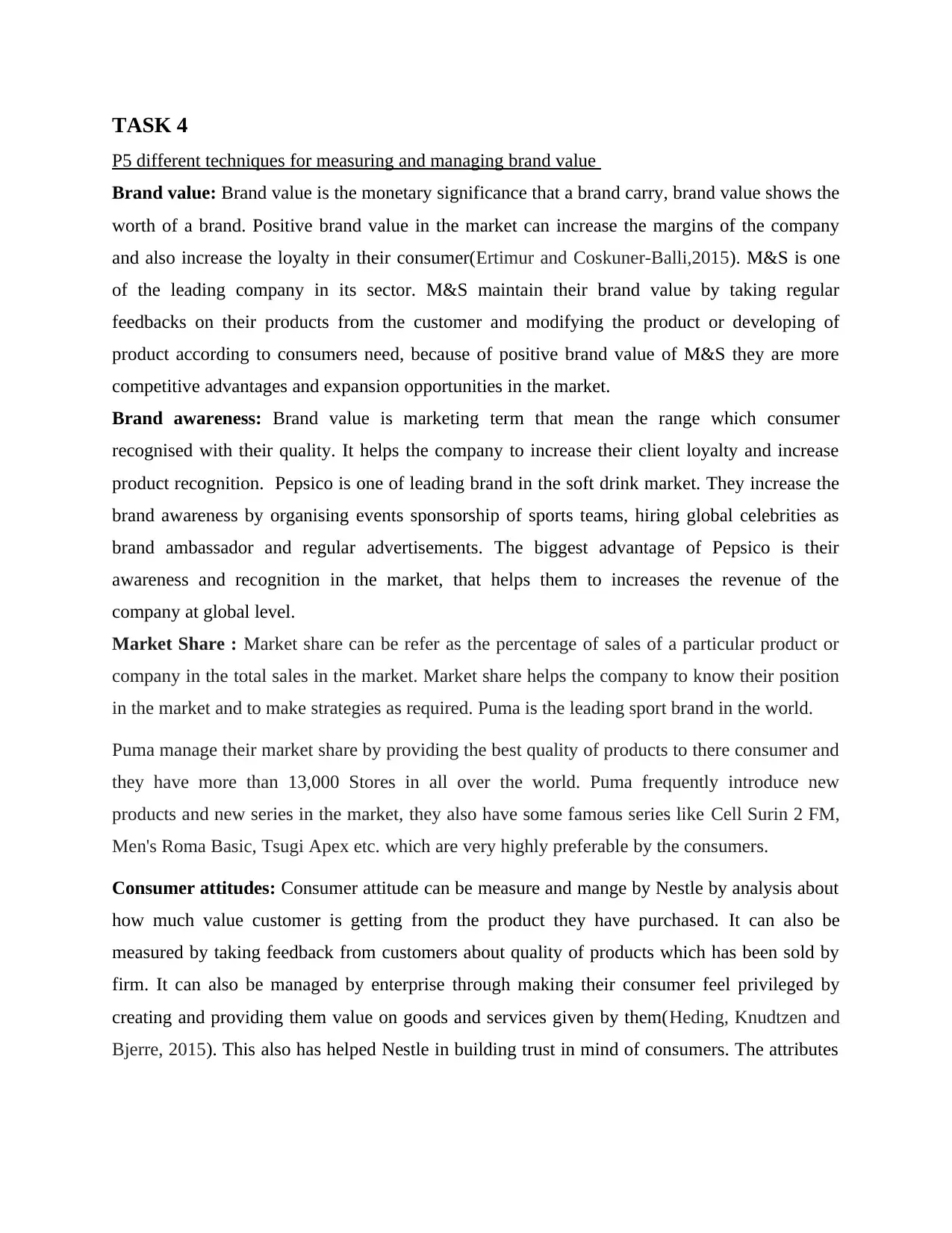
TASK 4
P5 different techniques for measuring and managing brand value
Brand value: Brand value is the monetary significance that a brand carry, brand value shows the
worth of a brand. Positive brand value in the market can increase the margins of the company
and also increase the loyalty in their consumer(Ertimur and Coskuner-Balli,2015). M&S is one
of the leading company in its sector. M&S maintain their brand value by taking regular
feedbacks on their products from the customer and modifying the product or developing of
product according to consumers need, because of positive brand value of M&S they are more
competitive advantages and expansion opportunities in the market.
Brand awareness: Brand value is marketing term that mean the range which consumer
recognised with their quality. It helps the company to increase their client loyalty and increase
product recognition. Pepsico is one of leading brand in the soft drink market. They increase the
brand awareness by organising events sponsorship of sports teams, hiring global celebrities as
brand ambassador and regular advertisements. The biggest advantage of Pepsico is their
awareness and recognition in the market, that helps them to increases the revenue of the
company at global level.
Market Share : Market share can be refer as the percentage of sales of a particular product or
company in the total sales in the market. Market share helps the company to know their position
in the market and to make strategies as required. Puma is the leading sport brand in the world.
Puma manage their market share by providing the best quality of products to there consumer and
they have more than 13,000 Stores in all over the world. Puma frequently introduce new
products and new series in the market, they also have some famous series like Cell Surin 2 FM,
Men's Roma Basic, Tsugi Apex etc. which are very highly preferable by the consumers.
Consumer attitudes: Consumer attitude can be measure and mange by Nestle by analysis about
how much value customer is getting from the product they have purchased. It can also be
measured by taking feedback from customers about quality of products which has been sold by
firm. It can also be managed by enterprise through making their consumer feel privileged by
creating and providing them value on goods and services given by them(Heding, Knudtzen and
Bjerre, 2015). This also has helped Nestle in building trust in mind of consumers. The attributes
P5 different techniques for measuring and managing brand value
Brand value: Brand value is the monetary significance that a brand carry, brand value shows the
worth of a brand. Positive brand value in the market can increase the margins of the company
and also increase the loyalty in their consumer(Ertimur and Coskuner-Balli,2015). M&S is one
of the leading company in its sector. M&S maintain their brand value by taking regular
feedbacks on their products from the customer and modifying the product or developing of
product according to consumers need, because of positive brand value of M&S they are more
competitive advantages and expansion opportunities in the market.
Brand awareness: Brand value is marketing term that mean the range which consumer
recognised with their quality. It helps the company to increase their client loyalty and increase
product recognition. Pepsico is one of leading brand in the soft drink market. They increase the
brand awareness by organising events sponsorship of sports teams, hiring global celebrities as
brand ambassador and regular advertisements. The biggest advantage of Pepsico is their
awareness and recognition in the market, that helps them to increases the revenue of the
company at global level.
Market Share : Market share can be refer as the percentage of sales of a particular product or
company in the total sales in the market. Market share helps the company to know their position
in the market and to make strategies as required. Puma is the leading sport brand in the world.
Puma manage their market share by providing the best quality of products to there consumer and
they have more than 13,000 Stores in all over the world. Puma frequently introduce new
products and new series in the market, they also have some famous series like Cell Surin 2 FM,
Men's Roma Basic, Tsugi Apex etc. which are very highly preferable by the consumers.
Consumer attitudes: Consumer attitude can be measure and mange by Nestle by analysis about
how much value customer is getting from the product they have purchased. It can also be
measured by taking feedback from customers about quality of products which has been sold by
firm. It can also be managed by enterprise through making their consumer feel privileged by
creating and providing them value on goods and services given by them(Heding, Knudtzen and
Bjerre, 2015). This also has helped Nestle in building trust in mind of consumers. The attributes
Paraphrase This Document
Need a fresh take? Get an instant paraphrase of this document with our AI Paraphraser
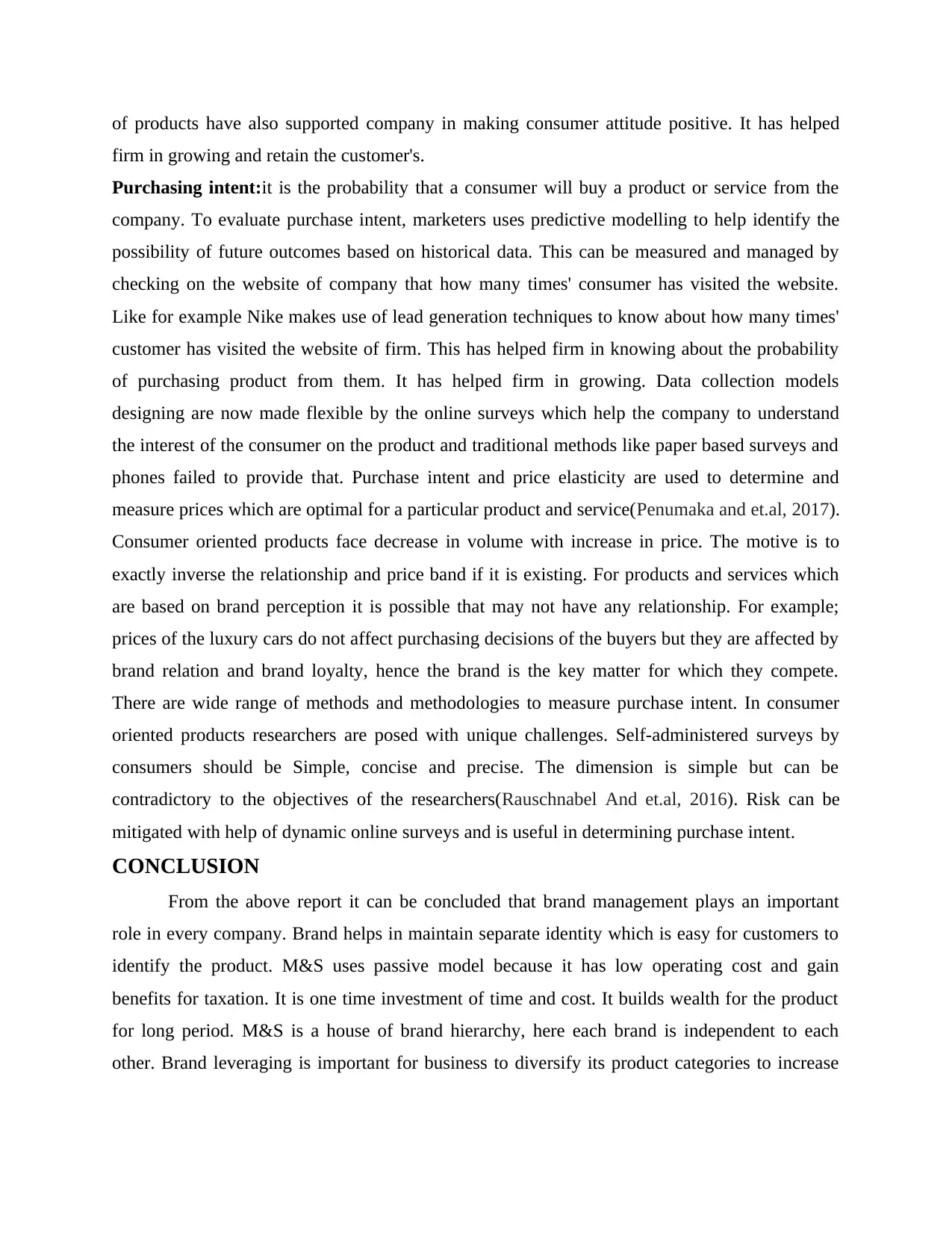
of products have also supported company in making consumer attitude positive. It has helped
firm in growing and retain the customer's.
Purchasing intent:it is the probability that a consumer will buy a product or service from the
company. To evaluate purchase intent, marketers uses predictive modelling to help identify the
possibility of future outcomes based on historical data. This can be measured and managed by
checking on the website of company that how many times' consumer has visited the website.
Like for example Nike makes use of lead generation techniques to know about how many times'
customer has visited the website of firm. This has helped firm in knowing about the probability
of purchasing product from them. It has helped firm in growing. Data collection models
designing are now made flexible by the online surveys which help the company to understand
the interest of the consumer on the product and traditional methods like paper based surveys and
phones failed to provide that. Purchase intent and price elasticity are used to determine and
measure prices which are optimal for a particular product and service(Penumaka and et.al, 2017).
Consumer oriented products face decrease in volume with increase in price. The motive is to
exactly inverse the relationship and price band if it is existing. For products and services which
are based on brand perception it is possible that may not have any relationship. For example;
prices of the luxury cars do not affect purchasing decisions of the buyers but they are affected by
brand relation and brand loyalty, hence the brand is the key matter for which they compete.
There are wide range of methods and methodologies to measure purchase intent. In consumer
oriented products researchers are posed with unique challenges. Self-administered surveys by
consumers should be Simple, concise and precise. The dimension is simple but can be
contradictory to the objectives of the researchers(Rauschnabel And et.al, 2016). Risk can be
mitigated with help of dynamic online surveys and is useful in determining purchase intent.
CONCLUSION
From the above report it can be concluded that brand management plays an important
role in every company. Brand helps in maintain separate identity which is easy for customers to
identify the product. M&S uses passive model because it has low operating cost and gain
benefits for taxation. It is one time investment of time and cost. It builds wealth for the product
for long period. M&S is a house of brand hierarchy, here each brand is independent to each
other. Brand leveraging is important for business to diversify its product categories to increase
firm in growing and retain the customer's.
Purchasing intent:it is the probability that a consumer will buy a product or service from the
company. To evaluate purchase intent, marketers uses predictive modelling to help identify the
possibility of future outcomes based on historical data. This can be measured and managed by
checking on the website of company that how many times' consumer has visited the website.
Like for example Nike makes use of lead generation techniques to know about how many times'
customer has visited the website of firm. This has helped firm in knowing about the probability
of purchasing product from them. It has helped firm in growing. Data collection models
designing are now made flexible by the online surveys which help the company to understand
the interest of the consumer on the product and traditional methods like paper based surveys and
phones failed to provide that. Purchase intent and price elasticity are used to determine and
measure prices which are optimal for a particular product and service(Penumaka and et.al, 2017).
Consumer oriented products face decrease in volume with increase in price. The motive is to
exactly inverse the relationship and price band if it is existing. For products and services which
are based on brand perception it is possible that may not have any relationship. For example;
prices of the luxury cars do not affect purchasing decisions of the buyers but they are affected by
brand relation and brand loyalty, hence the brand is the key matter for which they compete.
There are wide range of methods and methodologies to measure purchase intent. In consumer
oriented products researchers are posed with unique challenges. Self-administered surveys by
consumers should be Simple, concise and precise. The dimension is simple but can be
contradictory to the objectives of the researchers(Rauschnabel And et.al, 2016). Risk can be
mitigated with help of dynamic online surveys and is useful in determining purchase intent.
CONCLUSION
From the above report it can be concluded that brand management plays an important
role in every company. Brand helps in maintain separate identity which is easy for customers to
identify the product. M&S uses passive model because it has low operating cost and gain
benefits for taxation. It is one time investment of time and cost. It builds wealth for the product
for long period. M&S is a house of brand hierarchy, here each brand is independent to each
other. Brand leveraging is important for business to diversify its product categories to increase
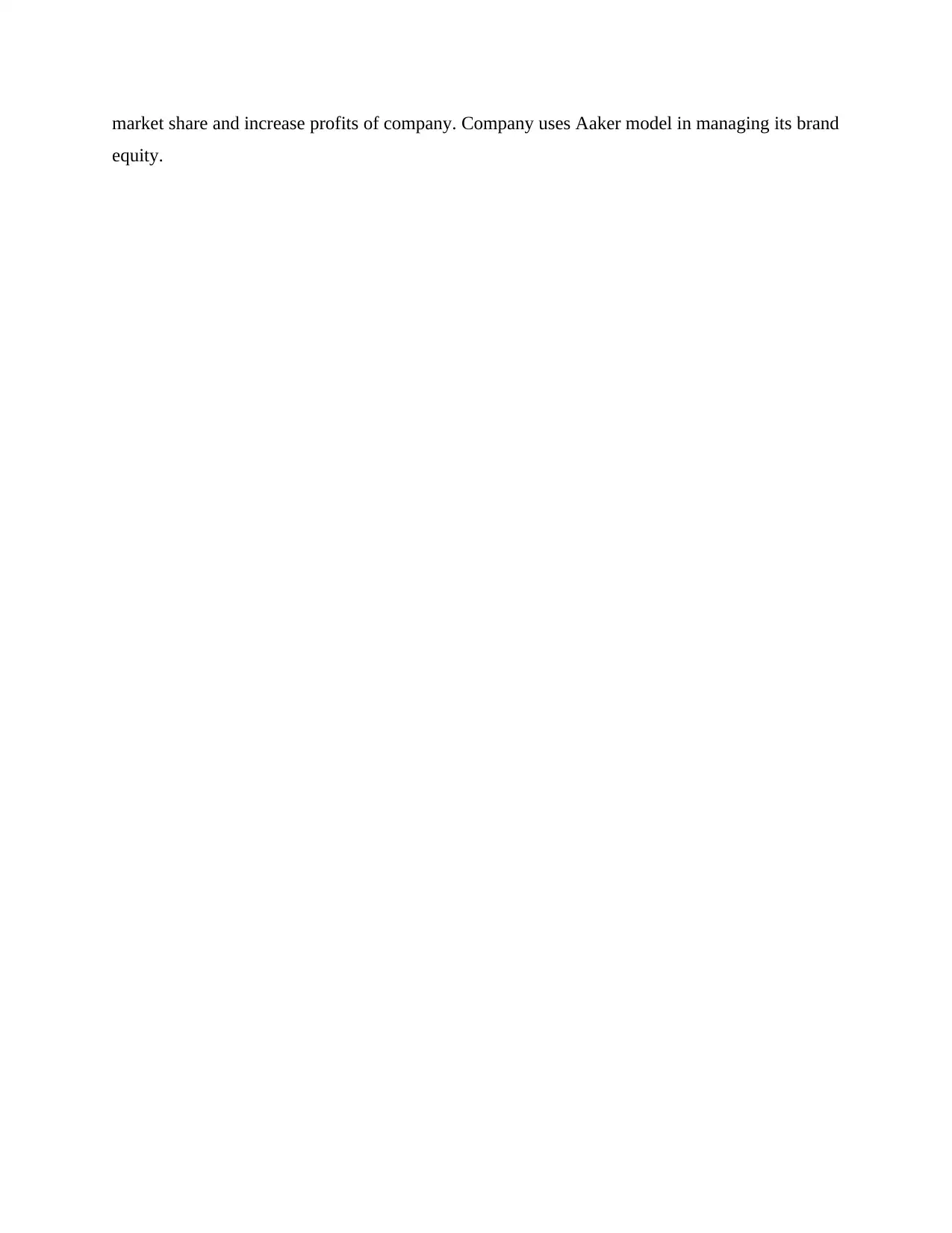
market share and increase profits of company. Company uses Aaker model in managing its brand
equity.
equity.
⊘ This is a preview!⊘
Do you want full access?
Subscribe today to unlock all pages.

Trusted by 1+ million students worldwide
1 out of 14
Related Documents
Your All-in-One AI-Powered Toolkit for Academic Success.
+13062052269
info@desklib.com
Available 24*7 on WhatsApp / Email
![[object Object]](/_next/static/media/star-bottom.7253800d.svg)
Unlock your academic potential
Copyright © 2020–2025 A2Z Services. All Rights Reserved. Developed and managed by ZUCOL.





